Darwin Bay is a collapsed caldera, open to the southwest to the ocean. Apparently the entrance across the drowned portion of the rim is tricky - we crossed at a crawl - but the inside, as we saw snorkeling, is very deep. Inside, you are surrounded on three sides by the interior walls of the caldera, and there are birds absolutely everywhere. More than we have seen anywhere else.
Darwin Bay has two landing sites, only about a half a mile apart. The Darwin Bay landing itself and Prince Phillip's Steps.
Darwin Bay Landing - Morning. We landed at Darwin Bay about 8:30 AM after a brief tour of the cliffs from Prince Phillip's Steps (our afternoon landing) counterclockwise to the southwesterly end of the crater. We had a wet landing on a coral cobble beach, then hiked westerly through the most amazing collection of birds on the trip. The Masked Boobies, Red-footed Boobies and Great Frigatebirds were on nests, in all stages from courtship to near-adult kids. There were a lot of Swallow-tail Gulls with kids, although most of the juveniles were fledged. The birds were utterly fearless. A Swallow-tail Gull fledgling flirted with Nancy for quite a long time.
As we walked the trail, very slowly as our professional photographers were burning film at a manic rate, we were gradually higher up and could look down on the nests of birds, as we picked our way around Masked Boobies nesting in the trail itself. There were Galapagos Fur Seals and Galapagos Sea Lions around, as well as a substantial numbers of marine iguanas.
There were Great and Magnificent Frigatebird rookeries, with each shrub carrying a nest or two, while males puffed out their gular sacks and pointed their bills at the sky, trying for a date. Great Frigatebird chicks in mid-fledge are surely one of largest, most homely birds on the planet.
Red-footed Booby chicks are miniature, white Big Birds, and seem to regard humans as just as likely as their parents to have food. The Masked Booby chicks were generally the youngest, although it was more a of majority process than an absolute rule. If the little bit of island we saw is anything like representative, there are tens of thousands of birds raising chicks on this small island.
Prince Phillip's Steps. After an okay but not great snorkel, we did our second landing on Tower Island, at Prince Phillip's Steps. The trail climbs through a narrow crack where a portion of the cliff face has pulled away from the bluff, and emerges onto a tableland that seems to be mostly lava. The trail crosses the crest of the southeasterly portion of the island, and then heads north back aways from the northerly bluff.
The area from the head of the steps to the northerly shore is covered in brush; the northerly portion is bare rock to a bluff dropping to the ocean.
The brushy area had a number of Magnificent and Great Frigatebirds and Masked Boobies, and an amazing number of Red-footed Boobies. Excellent views of chicks in all stages of development. On the northerly bluff there were clouds of Storm-petrels, as well as Audubon Shearwaters, Brown Noddys and Swallow-tail Gulls. With a little bit of work, we found a pair of Short-eared Owls on the lava, waiting for a Storm-petrel. We also located a cave shelf near the trail which was clearly a favored roost or nest of the owls.
We waited a while at the turn around spot. Boobies flew in and out; Masked Boobies coming in and Red-footed heading out. We watched both Small and Large Ground Finches scrabble in the gravel and rocks for seeds. We listened to Masked Boobies do their greeting calls and the calls of the hundreds - thousands - of storm-petrels filling the air. Clouds of birds fed on schools of fish just off-shore. The sense of abundance and unspoiled life was extraordinary.
We walked back in the late afternoon and early evening light. The lava and the brush were alive with birds. Swallows danced overhead and finches buzzed and cheeped all around us. More than any other place we had been, except perhaps Fernandina, you had a sense of what the Islands must have been like before man arrived.
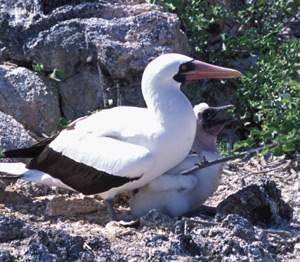
Masked Booby sheltering chick from sun
Tower Island
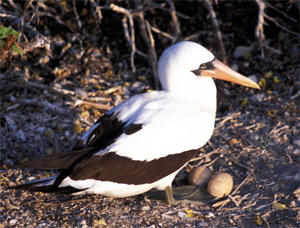 Masked Booby with two eggs Tower Island |
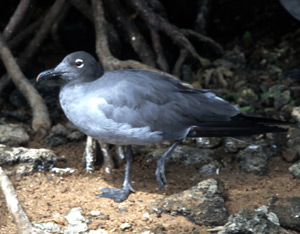 Lava Gull in mangrove Tower Island |
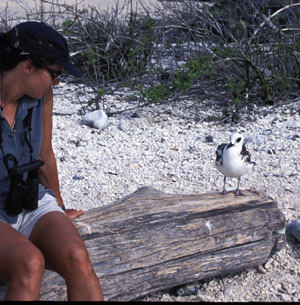 Nancy with Swallow-tail Gull fledgling Tower Island |
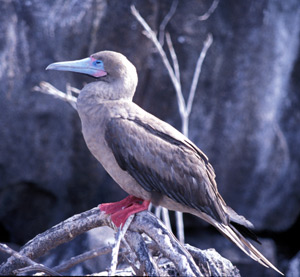 Red-footed Booby Tower Island |
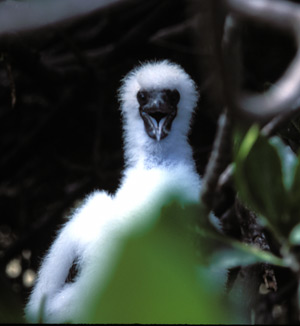 Red-footed booby chick Tower Island |
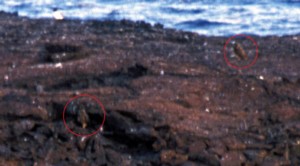 Grainy blow-up; the red circles mark Short-earred Owls Tower Island |
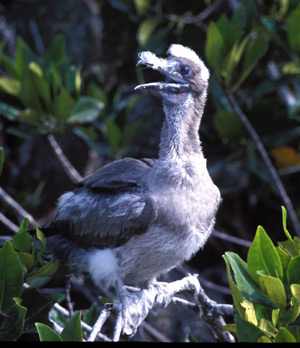 Frigatebird fledgling; a face only mother could love Tower Island |
|
Birds
|
Others
|
| Red-billed Tropicbird Wedge-rumped Storm-petrel Madeiran Storm-petrel Blue-footed Booby Red-footed Booby Masked Booby Galapagos Mockingbird Swallow-tail Gull Audubon Shearwater Magnificent Frigatebird Great Frigatebird Brown Pelican Brown Noddy Warbler Finch Yellow Warbler Sharp-beaked Finch Small Ground Finch Large Ground Finch Ruddy Turnstone Wandering Tattler Short-eared Owl Galapagos Dove Small Ground Finch |
Marine Iguana
Galapagos Sea Lion |